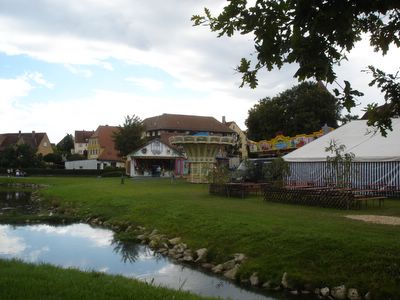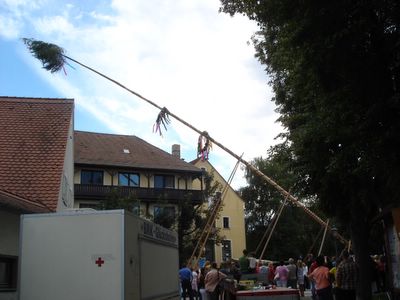Monday, September 11, 2006
Kirchweih

Near the end of August Wolframs-Eschenbach held it's Kirchweih fest down by the duck pond. It is an annual event, this is our 3rd time attending. It is exactly the same every year, even the people that run the rides are the same! I had plastic "tickets" left over from last year and they were using the same ones this year, so we were able to use them finally. We went down on Saturday to see the arrival and raising of the "kirchweihbaum", the traditional "tree" they put up every year. It resembles a Maypole, and it takes ages for the them to put up. Jacob and I watched for quite some time then decided to check out the rides. Finally, over an hour later as we were walking home we saw that it was finally up. Lots of beer and pretzel breaks for the guys that are raising the tree. They use wooden poles to lift it into place, moving them up little by little. Here is a picture of the tree and the poles they use to lift it...

Here is some history of why they have Kirchweih fests in Germany
Church Dedication ( Kirchweih)
When one sees the words Church Dedication, there comes to mind a solemn occasion marked with hymns and prayer, which is how it was in the third century when Kirchweih originated. As communities embraced the Christian faith, they constructed their village church, which was dedicated with a Sunday ceremony. The ceremonies always took place between the summer solstice, June 24 th, and St. Martin’s Day, November 11 th, and were then celebrated annually. By the time of Pope Gregor (599-604), the celebrations had become festivals lasting several days and involving much feasting and drinking, so much so that the pope rebuked the parishioners, but to little or no avail. The time of year lent itself to festivity; warm weather and long days produced euphoria, well illustrated by the following old German adage:
Der Juli voller Sonnenschein,
Wird jederman willkommen sein.
Lots o’ sunshine in July,
We welcome that, both you and I.
Long hot days meant hard work for the farmers and their families who had raging thirsts on return from the fields after tending their demanding crops. Kirchweih was an excuse to slake those thirsts and to let their euphoria boil over.
Today, although celebrated more in rural communities than cities, Kirchweih has become a major event on the calendar. Each town, village, or even hamlet has a date for the festival between June 24 th and November 11 th, and the dates seem to be set so that within a grouping of communities no two Kirchweih overlap, allowing townspeople to visit most festivals, if not all. Travelling entertainers, bands, food suppliers, and operators of sideshows and joyrides also move from one festival to the next.
The Kirchweih tree, a tall pine stripped of most of its branches, marks the location of a festival. The tree, cut near the root, decorated with ribbons and bearing a large gaily decorated handmade wreath near its peak, is manhandled to a prepared hole at some high point of the town. There it is to be raised with ropes and supports until it beds itself in the hole. This act is all part of the Kirchweih celebration, watched and cheered on by the villagers, and it is the scene of considerable beer drinking by the brawny young men who do the work.
(This description taken from the website of the Jasper, Indiana German Club)
Jacob had a great time, we did also. The fest ended on a Monday night with a tremendous fireworks display, we woke Jacob up to watch it. It was really long and had really nice fireworks, amazing for such a small town.
When we were emptying out Jacob's room for his new bed, I found another ticket for one of the rides at the fest. Now I just have to keep track of it until next year and we can use it again.